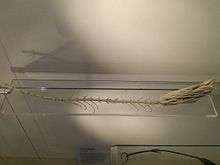Metacrinus rotundus
Metacrinus rotundus, the Japanese sea lily, is a marine invertebrate, a species of stalked crinoid in the family Isselicrinidae. It is a species found off the west coast of Japan, and is living near the edge of the continental shelf, around 100-150m deep. This is the shallowest species among the extant stalked crinoids.
| Metacrinus rotundus | |
|---|---|
 | |
| Scientific classification | |
| Kingdom: | |
| Phylum: | |
| Class: | |
| Subclass: | |
| Family: | |
| Genus: | |
| Species: | M. rotundus |
| Binomial name | |
| Metacrinus rotundus Carpenter, 1885 [1] | |
Description
In appearance, the Japanese sea lily resembles a feather duster. It has a central mouth surrounded by a crown of many-branched feeding arms. These are jointed and can coil up or unroll to expose the feathery pinnules on either side to the current. Each pinnule has several rows of tube feet and a central ambulacral groove that leads to a groove on the arm that continues down to the mouth. The crown is supported by a tough stalk composed of calcareous ossicles bound together by ligaments. At the base of the stalk is a disc-like sucker and the sides of the stalk bear five whorls of cirri (clawed appendages). The stalk continues lengthening during the animal's life and may reach 40 centimetres (16 in) and the arms can grow to half that length.[2][3]
Distribution and habitat
The Japanese sea lily occurs off the western coast of Japan. It is usually found within the depth range 100 to 150 metres (330 to 490 ft).[4] Abundant collection records are available from Sagami Bay and Suruga Bay. It is found attached by its stem to rocks, shells and other hard surfaces, using its cirri to anchor itself into position. It can move across the seabed using its arms but seldom does so.[2]
Biology
The Japanese sea lily is a filter feeder. It extends its arms towards the current, spreads its pinnules and gathers plankton and other particles floating past. These are transferred into the groove by its tube feet, wrapped in mucus and moved along the groove by the cilia that line it.[2]
If the Japanese sea lily is damaged, it can regenerate its arms and even the whole crown can be regenerated above the stalk.[5] In favourable locations, there may be a dense bed of sea lilies and it may form part of a rich micro-habitat with bivalve molluscs and brittle stars.[2]
Like other sea lilies, gametes are produced in specialised areas of the pinnules and liberated into the sea. After fertilisation the eggs hatch into barrel-shaped larvae that are planktonic for a few days before settling on the seabed, cementing themselves to hard surfaces, undergoing metamorphosis and developing into juvenile sea lilies[6]
References
- Messing, Charles (2012). "Metacrinus rotundus Linnaeus, 11758". WoRMS. World Register of Marine Species. Retrieved 2012-11-16.
- Hunter, Aaron. "Metacrinus rotundus (Japanese sea lily)". Natural History Museum. Retrieved 2012-11-16.
- Barnes, Robert D. (1982). Invertebrate Zoology. Holt-Saunders International. pp. 997–1007. ISBN 0-03-056747-5.
- Oji, T. and Kitazawa, K., 2006. Distribution of stalked crinoids (Echinodermata) from waters off the southern coasts of Japan. Memoir of the National Science Museum, Tokyo 41: 217-222.
- Amemiya, S. and Oji, T.: Regeneration in sea lilies. Nature 357 (1992) 546-547.
- Amemiya, S., Omori, A., Tsurugaya, T., Hibino, T., Yamaguchi, M., Kuraishi, R., Kiyomoto, M. and Minokawa, T. 2016. Early stalked stages in ontogeny of the living isocrinid sea lily Metacrinus rotundus. Acta Zoologica, 97: 102-116. DOI: 10.1111/azo.12109